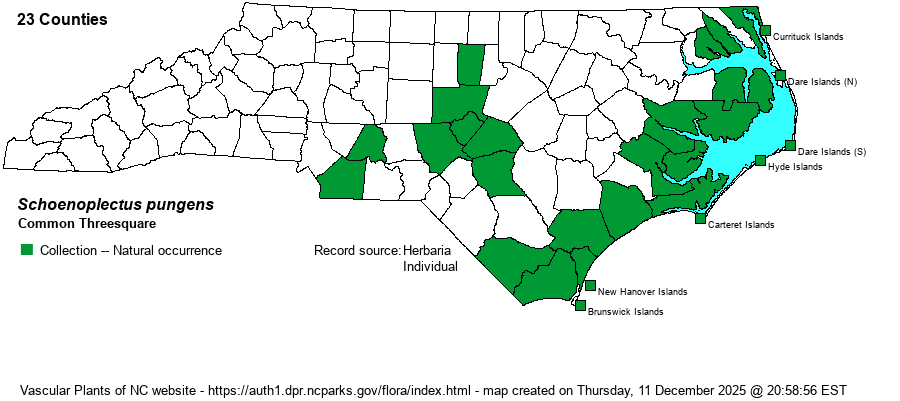| Author | (Vahl) Palla | |
| Distribution | Mostly the outer Coastal Plain and the Outer Banks/barrier islands; disjunct to the lower Piedmont and a few Coastal Plain Fall Line counties. Absent from the Sandhills proper.
In North America, Newf. to AK, south to South America. Scarce over most of the interior of the Southeastern states. | |
| Abundance | Frequent to common in the outer Coastal Plain and Outer Banks/barrier islands; uncommon and local in the eastern Piedmont. Plants form large colonies or patches. The website editors suggest a State Rank of S3S4. | |
| Habitat | Fresh-tidal to brackish marshes above the zone of Black Needlerush (Juncus roemerianus), rocky or sandy brownwater river shores or riffles. Often grows with Olney's Threesquare (S. americanus) in brackish marshes. | |
| Phenology | Flowering and fruiting June-September. | |
| Identification | The leafless stems are triangular in cross-section and grow 2-6 feet tall. The tallest plants are maritime; the shortest grow inland in rivers. Near the summit of each stem is a single compact cluster of spikelets, with an erect bract that looks as if it were a continuation of the stem. This species is very much like Olney's Threesquare, but Common Threesquare's color is dull green (vs. bright green), stems are merely triangular (vs. sharply so and with concave sides in Olney's Threesquare), and the inflorescence bracts are longer (3-20 cm long vs. 1-6 cm long in that species). | |
| Taxonomic Comments | Due to misidentification of the type specimen, Scirpus americanus needed a new name and Schoenoplectus pungens is it. Weakley (2018) lists var. pungens as the taxon present in NC.
The genus Schoenoplectus has been split from Scirpus and includes plants with sessile spikelets, or with spikelets with a few branches (vs. open, widely branching inflorescences). Most of our Schoenoplectus species appear to have no leaves (exceptions are S. etuberculatus and S. subterminalis), whereas Scirpus taxa have well-developed basal and stem leaves. | |
| Other Common Name(s) | Common Threesquare Bulrush, Sharp Clubrush | |
| State Rank | [S3S4] | |
| Global Rank | G5 | |
| State Status | | |
| US Status | | |
| USACE-agcp | OBL link |
| USACE-emp | OBL link |

